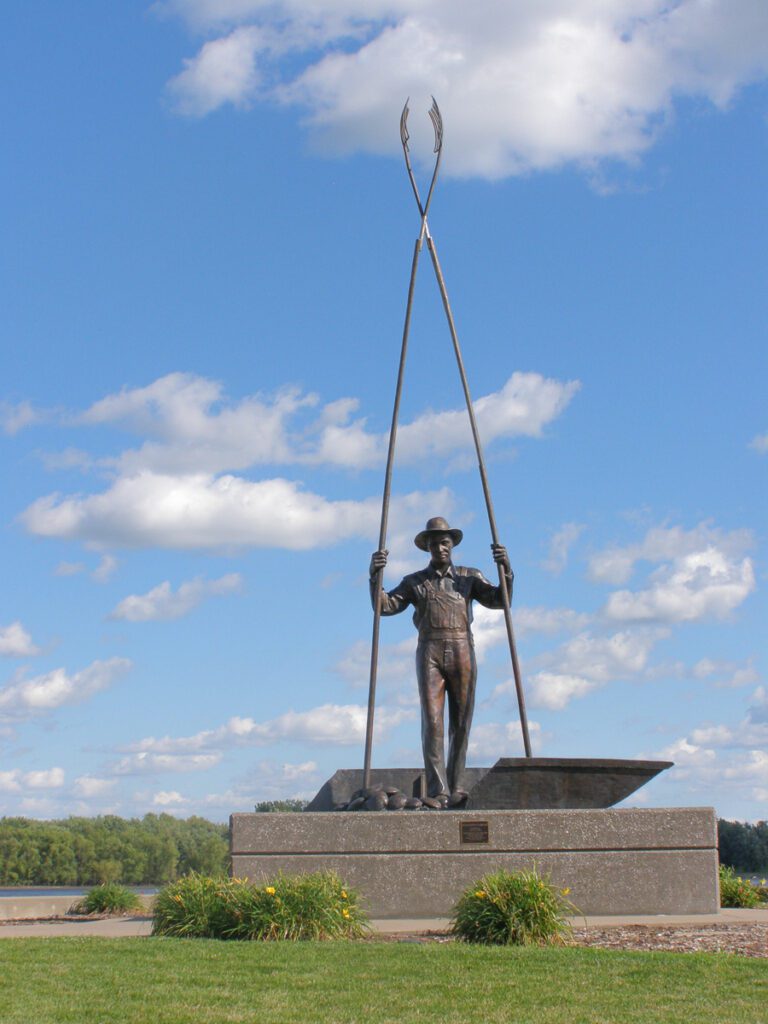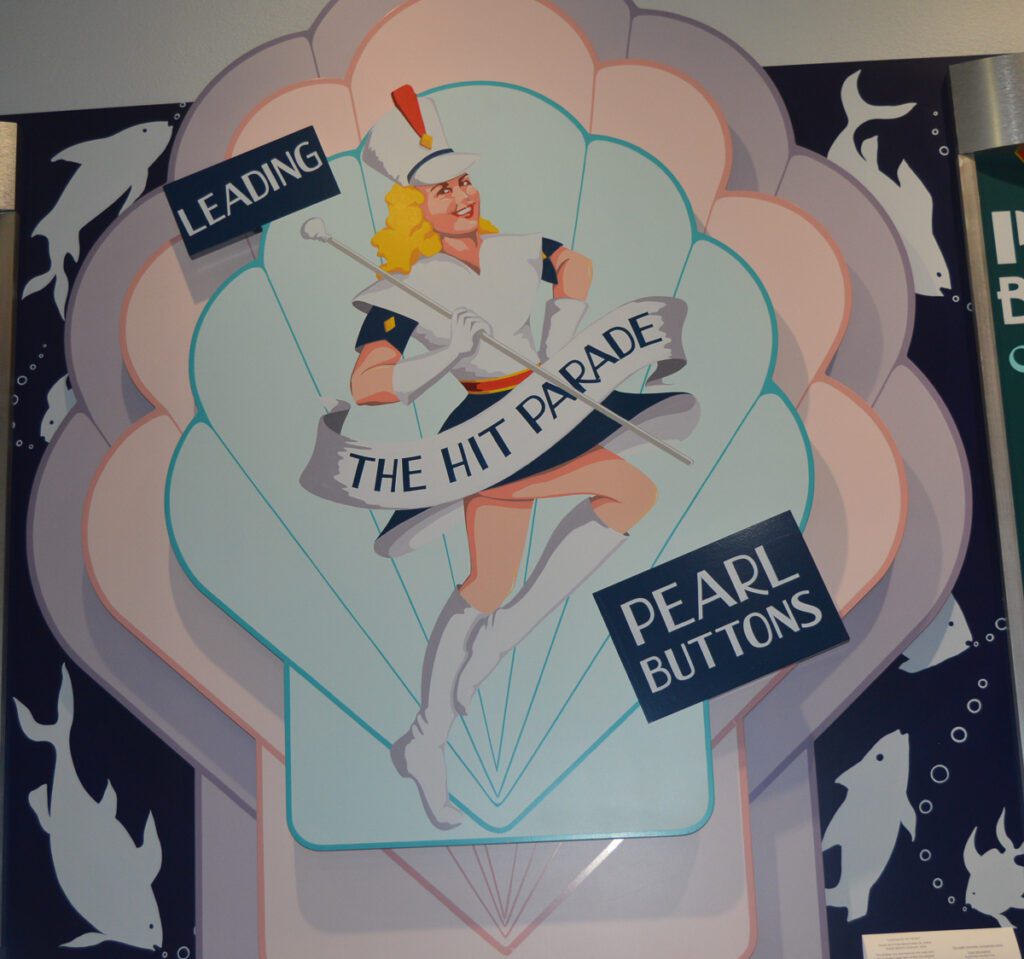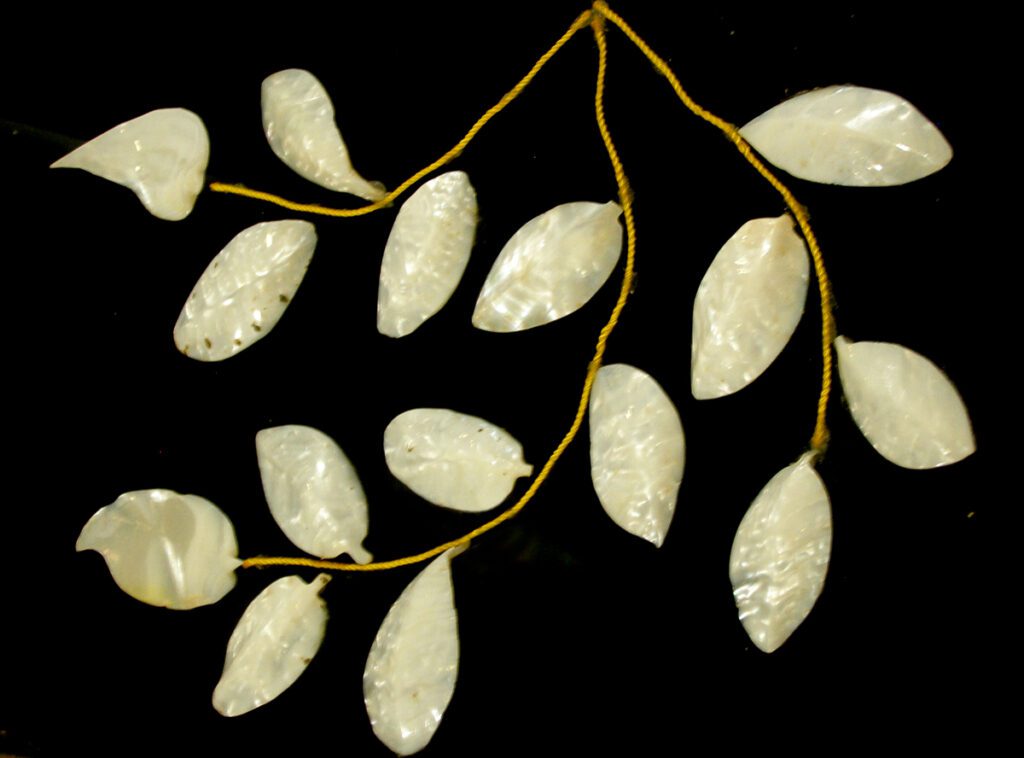Gold Rush of the Midwest
Here’s a question: What did people do before buttons were invented?
Before buttons, there was bone, brooch or some sort of crude pin that held two pieces of cloth together, typically at the shoulders or chest. Likely, these attachments rubbed the skin and made people uncomfortable.
Historians trace the first button use to the Indus Valley Civilization, at approximately 2000 BC, along the current day India/Pakistan border. Used then as more ornamental than functional, those early buttons were most common on male clothing and indicated village stature. Those buttons, made from an arched shell, gave the world an invention that has affected all of us positively, forevermore.
Bivalve mollusks, like clams, can be found in both fresh- and salt- water environments. Composed of calcium carbonate, the two types of clams are soft-shell, which is larger, with a thinner, more brittle outer shell or the hard-shell, smaller, thicker, tougher and difficult to open. Both are pearl producing.
Fast forward to John F. Boepple, Muscatine, Iowa and the late 1890’s. https://www.iowapbs.org/iowapathways/mypath/2697/pearl-button-story
Born in the mid-1800’s near Hamburg, Germany, Boepple was raised in a button-making family, becoming an expert in that trade. By then, buttons were fashioned from many sources, jewels, metals, wood and more. Boepple’s specialty were those made from multi-hued shells, particularly clam or mussel shells. When German tariffs essentially forced his family to close shop, Boepple was lost and floundering. Then, a friend returned from America with beautiful mussel shells gotten from “a big river west of Chicago”. This river was choking with clams and mussels. Boepple felt the call.

Arriving in Chicago in 1887, Boepple began following rivers west, hoping to run into the big one. Starting with the Sangamon River, he found shells while bathing. Those shells were too fragile for cutting, however, and had to be discarded.
Eventually, Boepple gazed at the mighty Mississippi and knew he was home.
The Great River flows 2340 miles from St. Paul, Minnesota to the Gulf of Mexico, exceeding widths of a mile. The river journey is a north to south direction, except for one segment, approximately thirty miles, that flows east to west. That section begins in the current day Quad Cities, ending in Muscatine. Here was the bonanza Boepple had sought! The Mississippi River – WorldAtlas
Because the Mighty Miss turns sharply south at Muscatine, the shores became lined with clams and mussels cast aside by the tide. They could be gathered and picked up everywhere.
But Boepple had difficulty with English and no money to begin making buttons. Few people were interested in loaning a non-English speaker money for a business they did not see profitable or important. Boepple was forced to find work as a farm laborer, saving his meager wage and building foot-powered button cutting equipment in his spare time. He also walked the shoreline daily, gathering shells, cutting and polishing buttons, which he sold to the housewives of Muscatine. Suddenly, there was interest in this immigrant.
In 1891 the Boepple Button Company opened its doors in a small one-room shop in Muscatine. Boepple did it all, gathered, cut, polished and sold those buttons door-to-door.
A few residents offered capitol and within a year, Boepple’s company had moved into a larger space, more cutting and polishing equipment was built, and men were being trained. The industry took off and Muscatine suddenly exploded, becoming the “Pearl Button Capitol” of the world.

John Boepple was a skilled button maker. Sadly, he was not a skilled businessman, and his lack of English was his biggest handicap. Within a few years of opening shop, fifty-three other shops were also operating in Muscatine. Boepple was struggling and eventually forced to close his doors.
Muscatine thrived. So did other Mississippi River towns. Along the one-hundred-fifteen miles between Clinton in the north to Burlington in the south, factory after factory opened and scooped thousands of shells from the river. In 1898, the state produced 138,615,696 buttons. Muscatine was the largest producer. Between 1908 and early the 1920’s, this city yielded 1.5 billion buttons, equaling one-third of the world’s supply. Streets and alleys overflowed with heaps of discarded shells.
All this was dubbed the “Gold Rush of the Midwest”.

Nearly every household in Muscatine was involved in the pearl button industry. Clammers could work as needed, harvesting from the river. This was ideal for farmers or schoolboys, who could work in clamming after chores or school for a few dollars during hard times.
Cutters and polishers were always men and the highest paid workers in the factory ($8 to $10 a week). A cutter used a rotating saw that put holes in the shells. Fortunately, buttons need to be many sizes, and the most exceptional cutter was able to use nearly all the shell.
The part cut out of the shell (the blank) was dropped in a bucket. Grinders, usually boys learning the trade, took the full pail to a machine that ground away the thick outer shell and cut the blanks to a uniform thickness.
Blanks then traveled to the finisher. Here the blanks carved out the center and drilled the holes that would attach the button to the garment. These were hand-fed machines, one blank at a time. And the button was formed.
Thousands of buttons were now dropped in an agitator with water and powdered pumice for half a day to make them shine. Lastly, the buttons were washed, sawdust dried and sent to the sorting tables, where women and girls organized the heaps of buttons into size, quantity and color ($4 to $6 per week).
Housewives up and down the river spent evenings sewing buttons on cards, typically for 1 cent per five cards.
Clams were easy to catch. Clammers in fishing boats or walking along the shore with long poles dragged hooks along the river bottom.
Defined by the History of Muscatine County in 1912:
“It is the habit of the clam to lie with his mouth open upstream, to catch little morsels of food that are carried down… and when one of those wire hooks touches his tender lips, the wretched fool grabs it, closes his shell upon it and holds on…”
After the clams were killed and cleaned by boiling, the shells were pried apart and the meat dumped out. No one ate the meat, as the Mississippi is muddy, and that mud taste saturated the meat.
A week’s soaking in water softened the shells, so they weren’t brittle when cutting.
Despite the huge success Boepple created, he continued to struggle. His language barrier was the biggest challenge. He believed his financial backers and partners were cheating him and stealing his unique knowledge and machinery. Frustrated, he devised ways to stay ahead of the game, by ordering unneeded machinery, and chemicals. He believed in the Old-World ways and eschewing much automation. In the end, he was forced out of the button industry.

But Boepple was the first to realize the clam industry was going to fail, because the clams were over fished. He warned the factories to slow down to let the clams stabilize.
Desperate to save the industry he created, he met with President McKinley and the Ways and Means Committee to add an import tax to the Dingley Bill.
He became the head at the nearby Fairport Biological Station in 1910 to study the proliferation of mussels. Redesigning the crowfoot hook, Boepple could prove this would prevent mussels from falling off, leaving no injured bivalves and only catching the larger shell, allowing smaller ones to grow.
Sadly, while in the river, studying mussels, Boepple cut his foot on a shell which caused a blood infection. He died in Muscatine in 1912.
In the end, the pearl button industry was killed not by lack of clams, but by plastic. Plastic buttons were easier, faster and much cheaper to make. Muscatine held on for as long as the city could, but the last pearl button factory closed in the 1950’s.
Muscatine is still referred to as the Pearl City.
This fascinating history is available to study at The National Pearl Button Museum in The History and Industry Center in Muscatine. This hand on interpretive center is worth the stop. Featuring films, pictures, displays, original equipment, and lots of buttons, the visitor is taken back to an era of desperate times and visionary people.

Admission is always free, donations are appreciated.
Visit this one-of-a-kind museum: The National Pearl Button Museum at the History and Industry Center
117 West 2nd Street
Muscatine, Iowa
563-263-1052